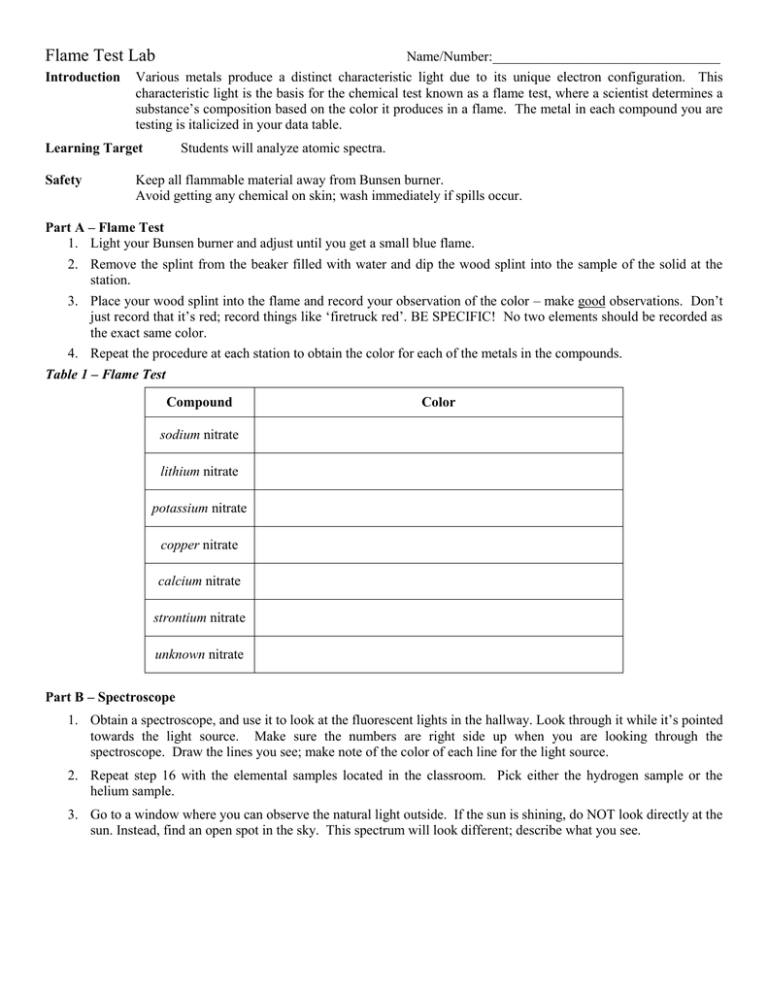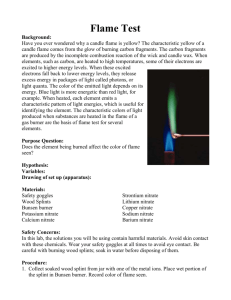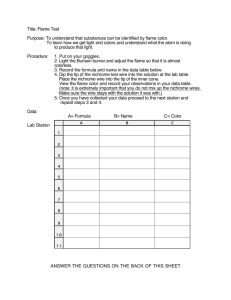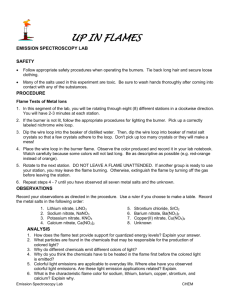16-Flame Test Lab
advertisement

Flame Test Lab Introduction Name/Number:_________________________________ Various metals produce a distinct characteristic light due to its unique electron configuration. This characteristic light is the basis for the chemical test known as a flame test, where a scientist determines a substance’s composition based on the color it produces in a flame. The metal in each compound you are testing is italicized in your data table. Learning Target Safety Students will analyze atomic spectra. Keep all flammable material away from Bunsen burner. Avoid getting any chemical on skin; wash immediately if spills occur. Part A – Flame Test 1. Light your Bunsen burner and adjust until you get a small blue flame. 2. Remove the splint from the beaker filled with water and dip the wood splint into the sample of the solid at the station. 3. Place your wood splint into the flame and record your observation of the color – make good observations. Don’t just record that it’s red; record things like ‘firetruck red’. BE SPECIFIC! No two elements should be recorded as the exact same color. 4. Repeat the procedure at each station to obtain the color for each of the metals in the compounds. Table 1 – Flame Test Compound Color sodium nitrate lithium nitrate potassium nitrate copper nitrate calcium nitrate strontium nitrate unknown nitrate Part B – Spectroscope 1. Obtain a spectroscope, and use it to look at the fluorescent lights in the hallway. Look through it while it’s pointed towards the light source. Make sure the numbers are right side up when you are looking through the spectroscope. Draw the lines you see; make note of the color of each line for the light source. 2. Repeat step 16 with the elemental samples located in the classroom. Pick either the hydrogen sample or the helium sample. 3. Go to a window where you can observe the natural light outside. If the sun is shining, do NOT look directly at the sun. Instead, find an open spot in the sky. This spectrum will look different; describe what you see. Table 2 – Spectroscope Light Source Color the light appears with the naked eye Drawings/Observations of Spectrum with Wavelength ----------l--------------------l--------------------l--------------------l---------400 nm 500 nm 600 nm 700 nm Fluorescent Elemental Sample Sun Questions Read the introduction and then answer each of the following questions in complete sentences. 1. Look at the names of the compounds you tested. All of them include the name ‘nitrate’. Do you think the nitrate portion of the compound emits the observed colors when energized? Explain. 2. What color did the unknown produced? What compound was in your unknown? Reference your data to support your answer. 3. Why do the chemicals have to be heated in the flame before the colored light is emitted? 4. Flame tests are good to use because of the small amount of the compound necessary to obtain a flame color. Based on your data and experiences, explain 2 chemical reasons why a flame test may NOT give an accurate account for the composition of a compound. Be sure to explain WHY your reasons would cause a problem. 5. If milk was boiling on a gas stove and it boiled over, what color flame would you expect to see? Explain your answer using your data in your answer. 6. During a flood, the labels from three bottles of chemicals were lost. The three unlabeled bottles of white solids were known to contain the following: strontium nitrate, ammonium nitrate and potassium nitrate. Explain how you could easily test the substances and re-label the three bottles. Reference your data in your answer. (Hint: Ammonium ions do not provide a distinctive flame color.) 7. The spectrometer is used to separate out the different wavelengths of light in part B of the lab. What was used to separate out the wavelengths when Bohr was examining the hydrogen line-emission spectrum? 8. Explain what was occurring that caused the colors you saw during the flame test. Use the following six vocabulary words from the chapter correctly in your explanation, and UNDERLINE each vocabulary word: absorption [absorb, absorbing, etc] excited state electron emission [emit, emitting, etc] wavelength ground state





